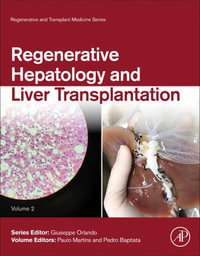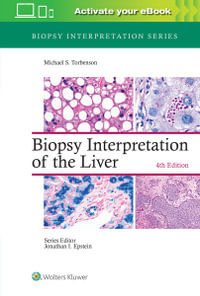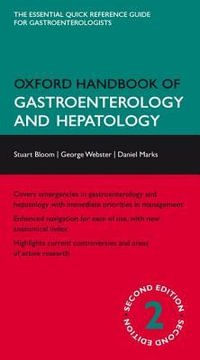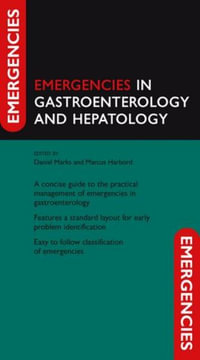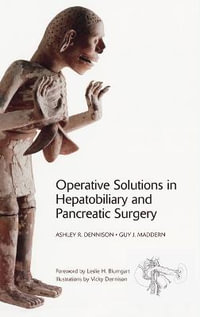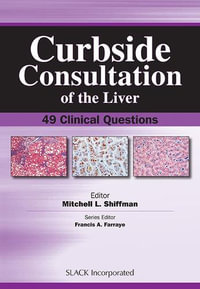
Key Consultations in Hepatology, An Issue of Clinics in Liver Disease
Volume 13-2
By: Paul Martin
Hardcover | 18 June 2009 | Edition Number 1
At a Glance
240 Pages
22.86 x 15.88 x 1.27
Hardcover
RRP $163.95
$129.75
21%OFF
or 4 interest-free payments of $32.44 with
orAims to ship in 5 to 10 business days
| Preface | p. xi |
| The Asymptomatic Outpatient with Abnormal Liver Function Tests | p. 167 |
| Traditionally, the constellation of biochemistry tests including liver enzymes, total bilirubin, and hepatic synthetic measures (prothrombin time (PT) and serum albumin level) are referred to as liver function tests (LFTs). Abnormal LFTs can be encountered during primary health care visits, routine blood donation, and insurance screening. A reported 1% to 4% of asymptomatic patients exhibit abnormal LFTs, leading to a sizeable number of annual consultations to a gastroenterology and/or hepatology practice. A cost-effective and systematic approach is essential to the interpretation of abnormal LFTs. A review of pattern of abnormal LFTs, detailed medical history, and a comprehensive physical examination help establish a foundation for further individualized testing. Further investigation often involves biochemical testing for disease-specific markers, radiographic imaging, and even consideration of a liver biopsy. In the following account, markers of hepatic injury are reviewed followed by a discussion on an approach to various patterns of abnormal LFTs in an asymptomatic patient. | |
| The Hospitalized Patient with Abnormal Liver Function Tests | p. 179 |
| Evaluation of abnormal liver function tests (LFTs) in the hospitalized patient is typically more urgent than the outpatient setting. This process is best organized into four steps. The first step is to determine whether the abnormal LFTs are associated with the illness resulting in the admission to the hospital or preceded the present illness. The second is to determine the etiology of the underlying liver disease. The third step is to evaluate the severity of the liver dysfunction and determine if acute liver failure (ALF) or acute decompensation of chronic liver failure is present. The final step is to look for the presence of associated complications-either those of ALF or chronic liver failure as appropriate. | |
| Approach to a Liver Mass | p. 193 |
| Incidentally discovered liver masses are becoming more common with the increasing application and power of imaging techniques for the evaluation of abdominal conditions. Although such masses are often benign, conclusive diagnoses must be established in order to provide appropriate patient care. Various imaging modalities can be utilized to accurately diagnose such masses without resort to more invasive diagnostic measures. | |
| Surgery in the Patient with Liver Disease | p. 211 |
| The advent of liver transplantation has greatly improved the long-term survival of patients with decompensated cirrhosis, and surgery is now performed more frequently in patients with advanced liver disease. The estimation of perioperative mortality is limited by the retrospective nature of and biased patient selection in the available clinical studies. The overall experience is that, in patients with cirrhosis, use of the Child classification and Model for End-Stage Liver Disease (MELD) score provides a reasonably precise estimation of perioperative mortality. Careful preoperative preparation and monitoring to detect complications early in the postoperative course are essential to improve outcomes. | |
| Modern Diagnosis and Management of Hepatocellular Carcinoma | p. 233 |
| The incidence of hepatocellular carcinoma (HCC) is rising, and the number of patients with HCC is expected to more than double over the next 1 to 2 decades. HCC meets the criteria for establishment of a surveillance program. Patients with cirrhosis, regardless of the cause, are at the highest risk for developing HCC and this is the population in which surveillance should be performed. (Alpha-fetoprotein and hepatic ultrasonography are the currently recommended surveillance tests. If a surveillance test is abnormal, there is a need for a recall test for diagnostic evaluation of HCC. Triple-phase imaging is recommended for evaluation at recall, with MRI being more sensitive and specific. Novel genetic markers can improve the histologic diagnosis of early HCC. The Barcelona staging classification is the best system for determining the prognosis of patients and it is linked to an evidence-based treatment algorithm. Resection, transplantation, and percutaneous ablation are considered curative interventions and are currently applied to about 30% of all patients with HCC. | |
| Nonalcoholic Fatty Liver Disease: A Practical Approach to Evaluation and Management | p. 249 |
| Non-alcoholic fatty liver disease (NAFLD) has become one of the most common forms of chronic liver disease in the Western world. The rise in NAFLD is thought to be associated with the prevalence of metabolic syndrome. NASH is a subtype of NAFLD that may progress to cirrhosis and end stage liver disease. Although there are no approved treatment regimens for NAFLD or NASH, a number of different interventions are being tested. Meanwhile, most experts advocate that components of metabolic syndrome should be effectively treated. | |
| Management of Alcoholic Liver Disease | p. 267 |
| Understanding alcohol addiction and abstinence is key to treating alcoholic liver disease, since abstinence leads to improvement in all forms of alcoholic liver damage. Although pharmacotherapy for alcoholism, using agents such as naltrexone, acamprosate, topiramate, and baclofen, is an exciting field, few studies have included patients with liver disease or cirrhosis. To treat alcoholic liver injury, corticosteroids have become the standard of care in patients with severe alcoholic hepatitis. In contrast, the role of pharmacotherapy to treat alcoholic fibrosis is unclear, with failure to observe a benefit in randomized, placebo-controlled clinical trials of colchicine, S-adenosylmethionine (SAMe), or phosphatidylcholine. Liver transplantation remains an option in selected patients with life-threatening alcoholic liver disease. | |
| Drug-Induced Hepatotoxicity or Drug-Induced Liver Injury | p. 277 |
| Drug-induced hepatotoxicity is underreported and underestimated in the United States. It is an important cause of acute liver failure. Common classes of drugs causing drug-induced hepatotoxicity include antibiotics, lipid lowering agents, oral hypoglycemics, psychotropics, antiretrovirals, acetaminophen, and complementary and alternative medications. Hepatotoxic drugs often have a signature or pattern of liver injury including patterns of liver test abnormalities, latency of symptom onset, presence or absence of immune hypersensitivity, and the course of the reaction after drug withdrawal. | |
| Management of Autoimmune and Cholestatic Liver Disorders | p. 295 |
| The management of autoimmune and cholestatic liver disorders is a challenging area of hepatology. Autoimmune and cholestatic liver diseases represent a comparatively small proportion of hepatobiliary disorders, yet their appropriate management is of critical importance for patient survival. In this article, management strategies are discussed, including the indications and expectations of pharmacologic therapy, endoscopic approaches, and the role of liver transplantation. | |
| Hepatitis Vaccination and Prophylaxis | p. 317 |
| The three most commonly identified causes of viral hepatitis in the United States are hepatitis A virus (HAV), hepatitis B virus (HBV), and hepatitis C virus (HCV). Hundreds of millions of people worldwide are infected by these viruses; many experience illness as a result. This article discusses current recommendations for vaccination and other forms of prophylaxis aimed at minimizing the clinical effects of these viruses. | |
| Care of the Cirrhotic Patient | p. 331 |
| Timely surveillance for varices and hepatocellular carcinoma, prophylaxis against spontaneous bacterial peritonitis (SBP) improve survival in patients awaiting transplantation. Early diagnosis of minimal or overt hepatic encephalopathy can delay life threatening complications, reduce need for hospitalization, and potentially improve survival pending liver transplantation. | |
| Index | p. 341 |
| Table of Contents provided by Ingram. All Rights Reserved. |
ISBN: 9781437704969
ISBN-10: 1437704964
Series: Clinics in Liver Disease
Published: 18th June 2009
Format: Hardcover
Language: English
Number of Pages: 240
Audience: Professional and Scholarly
Publisher: Saunders
Country of Publication: GB
Edition Number: 1
Dimensions (cm): 22.86 x 15.88 x 1.27
Weight (kg): 0.41
Shipping
| Standard Shipping | Express Shipping | |
|---|---|---|
| Metro postcodes: | $9.99 | $14.95 |
| Regional postcodes: | $9.99 | $14.95 |
| Rural postcodes: | $9.99 | $14.95 |
How to return your order
At Booktopia, we offer hassle-free returns in accordance with our returns policy. If you wish to return an item, please get in touch with Booktopia Customer Care.
Additional postage charges may be applicable.
Defective items
If there is a problem with any of the items received for your order then the Booktopia Customer Care team is ready to assist you.
For more info please visit our Help Centre.
You Can Find This Book In

Advances in Bariatric and Metabolic Endoscopy, An Issue of Gastrointestinal Endoscopy Clinics
Volume 34-4
Hardcover
RRP $195.00
$151.40
OFF

Bailey & Love's Essential Operations in Hepatobiliary and Pancreatic Surgery
Bailey & Love's Essential Operations
Hardcover
RRP $525.00
$371.50
OFF

Bailey & Love's Essential Operations in Hepatobiliary and Pancreatic Surgery
Bailey & Love's Essential Operations
Paperback
RRP $210.00
$150.75
OFF

Updates on Endoscopic Diagnosis in IBD
from White Light to Molecular Imaging, An Issue of Gastrointestinal Endoscopy Cl
Hardcover
RRP $195.00
$151.40
OFF

Advances in Intestinal Transplantation, Part II
The Immune Response with Intestinal Transplantation and the Bio-Artific
Paperback
RRP $163.00
$128.90
OFF

